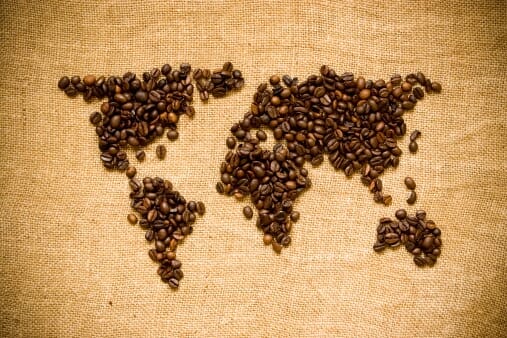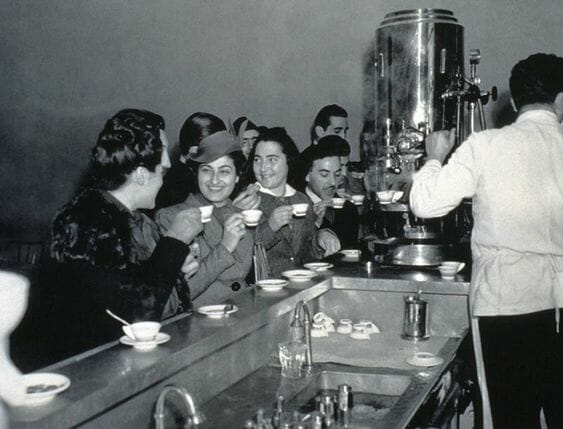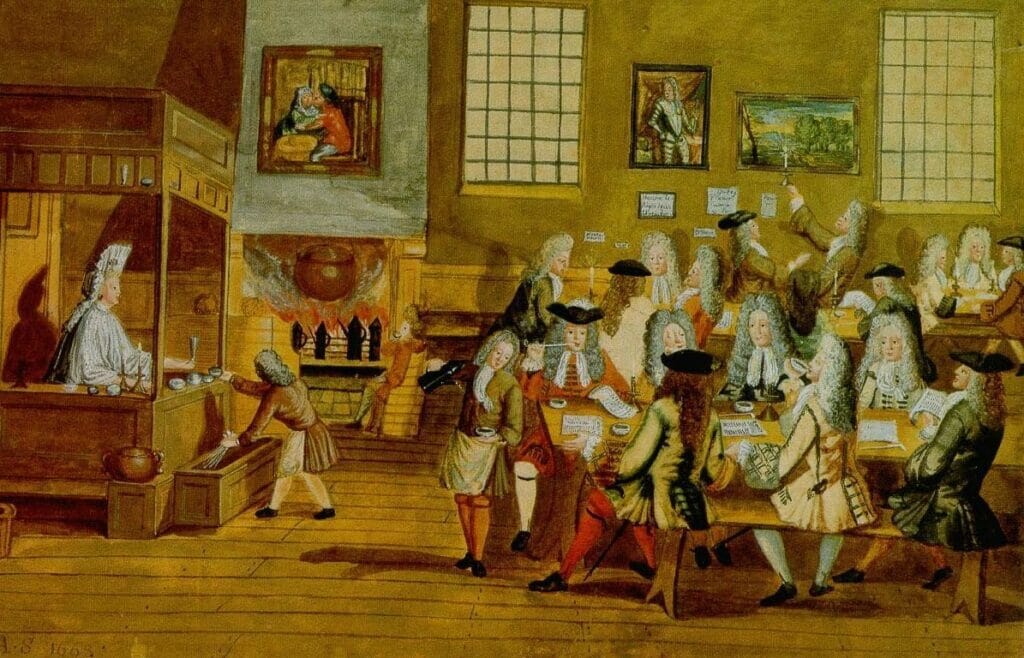Coffee is a must. We love it, we crave it and we rely on it to be cozy with friends, be social in coffee shops or get us through the day. 2.25 billion cups of coffee is estimated to be consumed each day worldwide. New Yorkers are said to drink 7 times the amount of any other U.S. city. Famed French writer and philosopher Voltaire was rumored to have drunk 40 – 50 cups per day.
Coffee is the second most valuable legally traded commodity in the world. Coffee is only preceded by oil as being the most valuable legally traded commodity – and that could very well be changing soon.
The word “coffee” has roots in several languages. In Yemen it earned the name qahwah, which was originally a romantic term for wine. It later became the Turkish kahveh, then Dutch koffie and finally coffee in English. As you can see, coffee (gahwah, kahveh, koffie) is a daily ritual around the globe in the lives of millions but where exactly did this caffeinated phenomenon begin and what is the history of coffee?
The history of coffee started with a goat
The history of coffee traces back centuries to the ancient coffee forests on the Ethiopian plateau. There, legend says the goat herder Kaldi first discovered the potential of these beloved beans.
According to legend, Kaldi discovered coffee after he noticed that after eating the berries from a certain tree, his goats became so energetic that they did not want to sleep at night. Kaldi reported his findings to the abbot of the local monastery, who made a drink with the berries and found that it kept him alert through the long hours of evening prayer.
The abbot shared his discovery with the other monks at the monastery, and knowledge of the energizing berries began to spread. As word moved east and coffee reached the Arabian peninsula, it began a journey which would bring these beans across the globe. And that’s how our history of coffee begins!

Coffee cultivation and trade began on the Arabian Peninsula
By the 15th century, coffee was being grown in the Yemeni district of Arabia and by the 16th century it was known in Persia, Egypt, Syria, and Turkey.
Coffee was not only enjoyed in homes, but also in the many public coffee houses — called qahveh khaneh — which began to appear in cities across the Near East. The popularity of the coffee houses was unequaled and people frequented them for all kinds of social activity.
Not only did the patrons drink coffee and engage in conversation, but they also listened to music, watched performers, played chess and kept current on the news. Coffee houses quickly became such an important center for the exchange of information that they were often referred to as “Schools of the Wise.”
With thousands of pilgrims visiting the holy city of Mecca each year from all over the world, knowledge of this “wine of Araby” began to spread and so does our history of coffee continue.
Then coffee came to Europe
Coffee reached Europe in the late 16th century through trade. European travelers to the Near East brought back stories of an unusual dark black beverage. By the 17th century, coffee had made its way to Europe and was becoming popular across the continent.
Some people reacted to this new beverage with suspicion or fear, calling it the “bitter invention of Satan.” The local clergy condemned coffee when it came to Venice in 1615. The controversy was so great that Pope Clement VIII was asked to intervene. He decided to taste the beverage for himself before making a decision, and found the drink so satisfying that he gave it papal approval.
Despite such controversy, coffee houses were quickly becoming centers of social activity and communication in the major cities of England, Austria, France, Germany and Holland. In England “penny universities” sprang up, so called because for the price of a penny one could purchase a cup of coffee and engage in stimulating conversation.
Coffee began to replace the common breakfast drink beverages of the time — beer and wine. Those who drank coffee instead of alcohol began the day alert and energized, and not surprisingly, the quality of their work was greatly improved.
The history of coffee continues in the U.S.
In the mid-1600’s, coffee was brought to New Amsterdam, later called New York by the British.
Though coffee houses rapidly began to appear, tea continued to be the favored drink in the New World until 1773, when the colonists revolted against a heavy tax on tea imposed by King George III. The revolt, known as the Boston Tea Party, would forever change the American drinking preference to coffee.
Plantations’ role in the history of coffee
As demand for the beverage continued to spread, there was fierce competition to cultivate coffee outside of Arabia.
The Dutch finally got seedlings in the latter half of the 17th century. Their first attempts to plant them in India failed, but they were successful with their efforts in Batavia, on the island of Java in what is now Indonesia.
The plants thrived and soon the Dutch had a productive and growing trade in coffee. They then expanded the cultivation of coffee trees to the islands of Sumatra and Celebes.

Coming to the Americas
In 1714, the Mayor of Amsterdam presented a gift of a young coffee plant to King Louis XIV of France. The King ordered it to be planted in the Royal Botanical Garden in Paris. In 1723, a young naval officer, Gabriel de Clieu obtained a seedling from the King’s plant. Despite a challenging voyage — complete with horrendous weather, a saboteur who tried to destroy the seedling, and a pirate attack — he managed to transport it safely to Martinique.
Once planted, the seedling not only thrived, but it’s credited with the spread of over 18 million coffee trees on the island of Martinique in the next 50 years. Even more incredible is that this seedling was the parent of all coffee trees throughout the Caribbean, South and Central America.
The famed Brazilian coffee owes its existence to Francisco de Mello Palheta, who was sent by the emperor to French Guiana to get coffee seedlings. The French were not willing to share, but the French Governor’s wife, captivated by his good looks, gave him a large bouquet of flowers before he left— buried inside were enough coffee seeds to begin what is today a billion-dollar industry.
Missionaries and travelers, traders and colonists continued to carry coffee seeds to new lands, and coffee trees were planted worldwide. Plantations were established in magnificent tropical forests and on rugged mountain highlands. Some crops flourished, while others were short-lived. New nations were established on coffee economies. By the end of the 18th century, coffee had become one of the world’s most profitable export crops.
Coffee in Italy
Espresso is the product of a preparation process that evolved in Italy over the first half of the 20th century, and by now has become almost an icon of the country itself. „Italian-style coffee‟ pertains to all forms of coffee beverages using an espresso base.
Italy truly emerged as the global leader in coffee thanks to Milanese inventor Luigi Bezzera. In 1901, Bezzera came up with the idea of forcing pressurized water through a handful of coffee powder to produce a short, concentrated drink: the espresso, so called because it could be prepared expressly for each customer and because the water had to be expressed through the coffee.
Quick to make and good to wake, the espresso became a futuristic icon at the turn of the century, sharing its name with a high-speed train. Espresso machines found their place in so-called “American bars”—spaces where people would stand at the bar, saloon-style, instead of sitting down at the table.
The first American bar in Italy was Caffé Maranesi, in Florence, nicknamed Caffè dei Ritti after the standing people that populated it (ritti means “upright” in Italian).

5 attempts to ban coffee
1. MECCA
Coffee was banned in Mecca in 1511, as it was believed to stimulate radical thinking and hanging out — the governor thought it might unite his opposition. Java also got a bad rap for its use as a stimulant — some Sufi sects would pass around a bowl of coffee at funerals to stay awake during prayers.
2. ITALY
When coffee arrived in Europe in the 16th century, clergymen pressed for it to be banned and labeled Satanic. But Pope Clement VIII took a taste, declared it delicious, and even quipped that it should be baptized. On the strength of this papal blessing, coffeehouses rapidly sprang up throughout Europe.
3. CONSTANTINOPLE
After Murad IV claimed the Ottoman throne in 1623, he quickly forbade coffee and set up a system of reasonable penalties. The punishment for a first offense was a beating. Anyone caught with coffee a second time was sewn into a leather bag and thrown into the waters of the Bosporus.
4. SWEDEN
Sweden gave coffee the ax in 1746. The government also banned “coffee paraphernalia” — with cops confiscating cups and dishes. King Gustav III even ordered convicted murderers to drink coffee while doctors monitored how long the cups of joe took to kill them, which was great for convicts and boring for the doctors.
5. PRUSSIA
In 1777, Frederick the Great of Prussia issued a manifesto claiming beer’s superiority over coffee. He argued that coffee interfered with the country’s beer consumption, apparently hoping a royal statement would make Prussians eager for an eye-opening brew each morning. Frederick’s statement proclaimed, “His Majesty was brought up on beer,” explaining why he thought breakfast drinking was a good idea.
The history of coffee concluded
Luckily coffee wasn’t banned forever and we get to enjoy it every day in the comfort of our own home using our Son of a Barista coffee maker (wink wink). Starting the history of coffee with a goat in Ethiopia and fast forwarding to modern times where we can enjoy coffee made with beans from all over the world, the history of coffee is ever evolving. We’re now making modern drinks such as dirty chai latte and almond milk cappuccino with just the touch of a single button!





2 thoughts on “The ultimate guide to the history of coffee”
Thanks. Learned some things about my favorite beverage!
Super interesting. Shared to my twitter